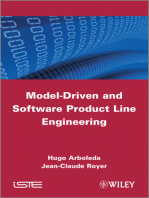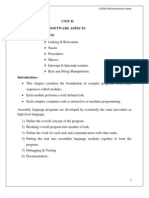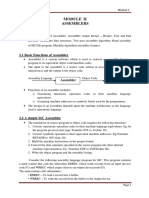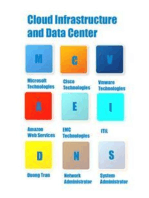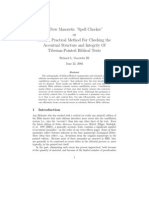Object_Code_Forms_Detailed_Clean
Uploaded by
bebamop569Object_Code_Forms_Detailed_Clean
Uploaded by
bebamop569Object Code Forms in Compilation
In the final phase of compilation, the compiler translates the intermediate representation of a program into an
object code that can be understood and executed by the target machine. The form of the object code
generated depends on the target platform, development workflow, and the need for flexibility, efficiency, and
modularity. The three major forms of object code are:
1. Absolute Machine Code
2. Relocatable Object Code
3. Assembly Language Code
Each of these object code forms has unique characteristics, use cases, and trade-offs.
1. Absolute Machine Code
Absolute machine code is the raw binary format directly executable by the processor. It contains instructions
with fixed memory addresses.
- Characteristics:
- Immediate execution: No need for linking or relocation.
- Simplicity: Easier to implement for simple compilers.
- Used in small systems or educational tools like WATFIV, PL/C.
- Limitations:
- No flexibility: Every program must be loaded at the same memory address.
- Difficult to support modular programming or libraries.
- Not reusable or shareable in multi-program environments.
Example: Absolute Machine Code
Memory Address | Instruction
0x0000 | LOAD A
0x0001 | ADD B
0x0002 | STORE C
0x0003 | HALT
Object Code Forms in Compilation
2. Relocatable Object Code
Relocatable object code allows a program to be placed anywhere in memory at load time. It supports
separate compilation of modules and late binding during linking.
- Characteristics:
- Contains symbolic references and relocation information.
- Facilitates modular and large program development.
- Supports reuse of libraries and system calls.
- Advantages:
- Enhances memory management flexibility.
- Reduces recompilation overhead when only some modules change.
- Requirement:
- Needs a linker to resolve addresses and produce executable code.
Example: Relocatable Code Snippet
Symbol Table:
START -> Offset 0x0040
Instruction: JMP START ; Linker resolves actual address
3. Assembly Language Code
Assembly code is a human-readable representation of machine instructions. It must be assembled into
machine code by an assembler.
- Characteristics:
- Easier for programmers to read, debug, and optimize.
- Supports macros and symbolic labels.
- Often used in system-level or embedded development.
Object Code Forms in Compilation
- Advantages:
- Provides visibility into low-level operations.
- Allows insertion of special machine instructions not exposed in high-level languages.
- Drawbacks:
- Requires an additional assembly step.
- Less portable compared to high-level code.
Example: Assembly Code
MOV AX, 0010h
ADD AX, BX
MOV [RESULT], AX
Comparison of Object Code Forms
| Code Form | Readable | Direct Execution | Linking Required | Use Case |
|------------------------|----------|------------------|-------------------|----------------------------------|
| Absolute Machine Code | No | Yes | No | Educational tools, small systems |
| Relocatable Code | No | No | Yes | Modular, large systems |
| Assembly Code | Yes | No | Yes (after ASM) | System-level, embedded coding |
Conclusion
Choosing the right form of object code is essential for balancing performance, modularity, and development
complexity. Absolute code is fast and simple, but inflexible. Relocatable code is ideal for complex and
modular software development. Assembly code offers low-level control and is crucial in performance-critical
or hardware-near applications.
Modern compilers often produce relocatable code or assembly code, which is then processed further by
linkers and loaders to generate final executables.
You might also like
- The First Book of Enoch: The Oldest Book In History100% (2)The First Book of Enoch: The Oldest Book In History276 pages
- Computer Science: Learn about Algorithms, Cybersecurity, Databases, Operating Systems, and Web DesignFrom EverandComputer Science: Learn about Algorithms, Cybersecurity, Databases, Operating Systems, and Web DesignNo ratings yet
- Embedded Systems Programming with C: Writing Code for MicrocontrollersFrom EverandEmbedded Systems Programming with C: Writing Code for MicrocontrollersNo ratings yet
- Mastering the Art of x86 Assembly Programming: Unlocking the Secrets of Expert-Level SkillsFrom EverandMastering the Art of x86 Assembly Programming: Unlocking the Secrets of Expert-Level SkillsNo ratings yet
- Assignment No.: 01: Name: Shraddha Umesh Mulay Roll No.: 221083 GR No.: 22020260 Sy-ANo ratings yetAssignment No.: 01: Name: Shraddha Umesh Mulay Roll No.: 221083 GR No.: 22020260 Sy-A8 pages
- Embedded Systems Programming with C++: Real-World TechniquesFrom EverandEmbedded Systems Programming with C++: Real-World TechniquesNo ratings yet
- C++ Basics for New Programmers: A Practical Guide with ExamplesFrom EverandC++ Basics for New Programmers: A Practical Guide with ExamplesNo ratings yet
- C# Fundamentals Made Simple: A Practical Guide with ExamplesFrom EverandC# Fundamentals Made Simple: A Practical Guide with ExamplesNo ratings yet
- Mastering Embedded C: The Ultimate Guide to Building Efficient SystemsFrom EverandMastering Embedded C: The Ultimate Guide to Building Efficient SystemsNo ratings yet
- Major Solution Components of Industrial Automation: Industrial Automation, #2From EverandMajor Solution Components of Industrial Automation: Industrial Automation, #2No ratings yet
- Java / J2EE Interview Questions You'll Most Likely Be AskedFrom EverandJava / J2EE Interview Questions You'll Most Likely Be AskedNo ratings yet
- Mastering Terraform A Comprehensive Guide to Infrastructure As CodeFrom EverandMastering Terraform A Comprehensive Guide to Infrastructure As CodeNo ratings yet
- Unit-Ii Software Aspects: Cse302 Microprocessor NotesNo ratings yetUnit-Ii Software Aspects: Cse302 Microprocessor Notes24 pages
- Image Collection Exploration: Unveiling Visual Landscapes in Computer VisionFrom EverandImage Collection Exploration: Unveiling Visual Landscapes in Computer VisionNo ratings yet
- The Software Programmer: Basis of common protocols and proceduresFrom EverandThe Software Programmer: Basis of common protocols and proceduresNo ratings yet
- Writing Clean Code Step by Step: A Practical Guide with ExamplesFrom EverandWriting Clean Code Step by Step: A Practical Guide with ExamplesNo ratings yet
- Software Suite: Revolutionizing Computer Vision with the Ultimate Software SuiteFrom EverandSoftware Suite: Revolutionizing Computer Vision with the Ultimate Software SuiteNo ratings yet
- C++ Debugging from Scratch: A Practical Guide with ExamplesFrom EverandC++ Debugging from Scratch: A Practical Guide with ExamplesNo ratings yet
- Lexicon of Programming Terminology: Lexicon of Tech and Business, #17From EverandLexicon of Programming Terminology: Lexicon of Tech and Business, #175/5 (1)
- Lect 1 - CPE 505 MIPS Assembly LanguageNo ratings yetLect 1 - CPE 505 MIPS Assembly Language36 pages
- Complier Design Btech 6th semester - CSE-A-B Unit 01No ratings yetComplier Design Btech 6th semester - CSE-A-B Unit 0133 pages
- C++ Functional Programming for Starters: A Practical Guide with ExamplesFrom EverandC++ Functional Programming for Starters: A Practical Guide with ExamplesNo ratings yet
- Digital Design of Signal Processing Systems: A Practical ApproachFrom EverandDigital Design of Signal Processing Systems: A Practical Approach5/5 (1)
- System Software: Assemblers, Linkers, and Loaders: Program DevelopmentNo ratings yetSystem Software: Assemblers, Linkers, and Loaders: Program Development17 pages
- Mastering the Craft of C++ Programming: Unraveling the Secrets of Expert-Level ProgrammingFrom EverandMastering the Craft of C++ Programming: Unraveling the Secrets of Expert-Level ProgrammingNo ratings yet
- Microsoft AZ-400: Designing and Implementing Microsoft DevOps Solutions - Certification Exam PrepFrom EverandMicrosoft AZ-400: Designing and Implementing Microsoft DevOps Solutions - Certification Exam PrepNo ratings yet
- C++ Algorithms for Beginners: A Practical Guide with ExamplesFrom EverandC++ Algorithms for Beginners: A Practical Guide with ExamplesNo ratings yet
- No Prep Rainy Day Fun Mathand Literacy Printables FREEBIE100% (1)No Prep Rainy Day Fun Mathand Literacy Printables FREEBIE6 pages
- IURI 371 21 - Evaluation of Evidence 2023-10-11 14 - 03 - 22No ratings yetIURI 371 21 - Evaluation of Evidence 2023-10-11 14 - 03 - 2212 pages
- Theory of Terminology and Cognitive Linguistics: On Categorization, Definition and NominationNo ratings yetTheory of Terminology and Cognitive Linguistics: On Categorization, Definition and Nomination14 pages
- Arabic: First Year Higher Secondary Model Examination - 2021No ratings yetArabic: First Year Higher Secondary Model Examination - 202112 pages
- CSE531 Software Reuse 15387::manpreet Kaur 3.0 0.0 0.0 3.0 Courses With Research FocusNo ratings yetCSE531 Software Reuse 15387::manpreet Kaur 3.0 0.0 0.0 3.0 Courses With Research Focus6 pages
- Hash Functions and Digital CertificatesNo ratings yetHash Functions and Digital Certificates10 pages
- Qing Fei de Yi (Meteor Garden Theme) : Original Lyrics Translation in English33% (3)Qing Fei de Yi (Meteor Garden Theme) : Original Lyrics Translation in English2 pages
- Showcase Self-Assessment Checklist Itl 522No ratings yetShowcase Self-Assessment Checklist Itl 5222 pages
- Football Politics and Identity 1 Edition James Carr Daniel Parnell Paul Widdop Martin J Power Stephen R Millar download pdf100% (3)Football Politics and Identity 1 Edition James Carr Daniel Parnell Paul Widdop Martin J Power Stephen R Millar download pdf50 pages
















